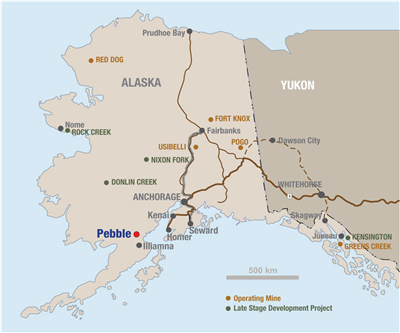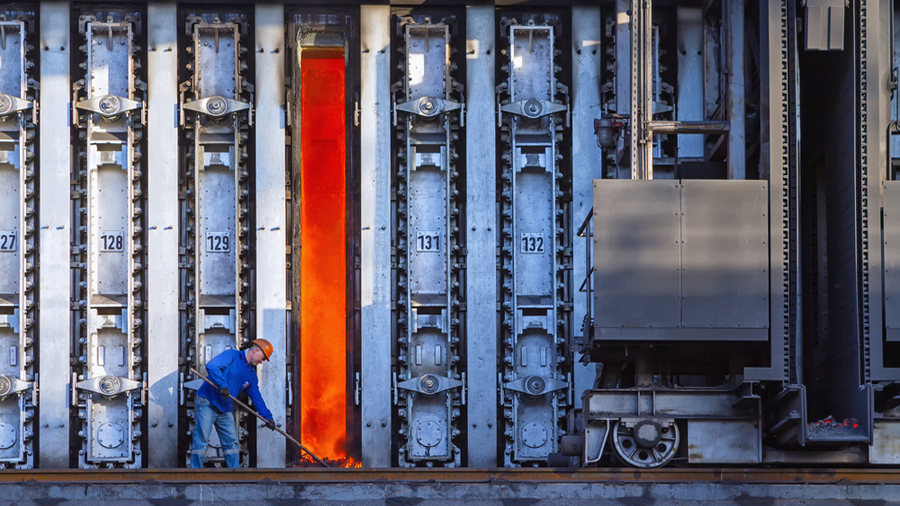81% of native corp. opposed to Pebble Mine

The Pebble Mine copper-gold-moly project in Southwestern Alaska got hit with another negative poll last week.
The Huffington Post reports that 81% of the roughly 2000 shareholders of the Bristol Bay Native Corporation — the regional Native corporation and largest private landholder in southwest Alaska — have rejected the mine on the basis that it will “unavoidably put at risk the ‘fisheries and our Native way of life.'”
The project is a partnership between Anglo American (LON:AAL) and Northern Dynasty Minerals (NYSEAMEX:NAK).
The poll result follows last month’s approval of the “Save Our Salmon” ordinance. Voters in the Lake and Peninsula Borough narrowly supported (by 34 votes) a ballot measure put forward by anti-Pebble activists that would restrict future development that affects more than one square mile of land within the 31,000 square mile borough.
The ordinance, however, is being challenged in court by the State of Alaska which argues that it seeks to undermine state authority over large-scale resource development:
In a statement, the Alaska Department of Law argues that the Lake & Peninsula Borough ordinance is invalid as it seeks to “nullify state permitting processes and prevent the development of certain large-scale resource development activity….While boroughs have limited power to regulate some of the activities associated with resource development, a small majority of voters in a local community cannot usurp the more comprehensive state authority and eliminate the entire state permitting process.”
According to Pebble Partnership, a lobbying group supporting the proposed mine, the area contains 80.6 billion lbs. of copper, 5.6 billion lbs. of molybdenum, and 107.4 million oz. of gold. The project is currently in a pre-feasibility and pre-permitting research stage. If the mine goes ahead, Pebble Partnership says it will bring the economically depressed region 1,000 high-skill, high-wage operation jobs and 2,000 construction-phase jobs.
Save Bristol Bay, a group lobbying against the project, maintains that the proposed mine runs a high risk of polluting Bristol Bay, in particular due to a massive tailings facility that would need to be built in close proximity to the bay:
Located in a seismically active region, Pebble would require the world’s largest earthen dam to be built, some 700 feet high and several miles in length. Independent scientists have questioned whether the dam could withstand the force of a massive earthquake, such as the 9.2 quake that devastated Anchorage in 1964.
The dam and 10-square-mile-wide containment pond are intended to hold between 2.5 billion and 10 billion tons of mine waste that Pebble would produce over its lifetime – nearly enough to bury the city of Seattle, WA. Because the sulfide, or acid-generating, nature of the Pebble ore body, the waste would require environmental treatment in perpetuity. Any release of mine waste into the surface or groundwater has the potential to harm Bristol Bay’s salmon runs.
The Pebble Partnership, which includes Anglo American, Northern Dynasty, and Rio Tinto, maintain that the companies are committed to environmental stewardship and the protection of the fishery.
Key finding from the PEA, released in February:
•The Pebble deposit supports open pit mining utilizing conventional drill, blast and truck-haul methods, with an initial mine life of 25 years and potential for mine extensions to 78 years and beyond.
•The potential exists for underground block cave development at a mining rate of 150,000 tons per day to emerge as the preferred mining method for phases of development beyond 25 years.
•The process plant employs conventional crush-grind-float technology and equipment with a nominal throughput of 200,000 tons per day, as well as secondary gold recovery. Average mill throughput for the first 25 years would be 219,000 tons per day, rising to 229,000 tons per day for the 45-year and 78-year cases.
Other project facilities and infrastructure include: a 378 megawatt natural gas-fired turbine plant at the mine site; an 86-mile transportation corridor to Cook Inlet for road and pipeline rights-of-way; and a new deep-water port on Cook Inlet.•Construction of the Pebble Project would take four years, and employ a peak labour force of 2,080. The operations workforce averages 1,120 over the first 25 years of mining.
•The 45-year Reference Case processes 3.8 billion tons of material with a strip ratio of 2.1:1 and average grades of 0.46% copper, 0.011 oz gold per ton and 214 ppm molybdenum.
•The 45-year Reference Case produces 31 billion lb copper, 30 million oz gold, 1.4 billion lb molybdenum, 140 million oz silver, 1.2 million kg rhenium and 907,000 oz palladium, while mining 32% of the total Pebble mineral resource.
•Economic valuations are expressed in US dollars in real terms utilizing long-term metal prices of $2.50/lb copper, $1,050/oz gold, $13.50/lb molybdenum, $15/oz silver, $3,000/kg rhenium and $490/oz palladium.
{{ commodity.name }}
{{ post.title }}
{{ post.date }}



4 Comments
Ozark
To bad that these mega-miners don’t look at alternative green technologies that don’t require toxic chemicals to extract the ore. Companies like Haber Inc. have shown they can extract the ore not only faster but are non-toxic. It is unfortunate that they are tied in and associated with a toxic past mindset.
Phillip Charles Goodwin
I hope to GOD that Bristol Bay ca be saved from the copper mineing company. If you want to see the results of copper mining go to Arizona. Travel south through the White Mountain Forest and you will cry when you come to the mine. It is a gapeing hole in Mother Nature!!!!
Shelley R.
I live in SLC, UT and it saddens me daily to see the tailings from the Kennecott mine and the haze that lingers in the valley as a result of the neglect of caring for the environment by the majority.
Russell_curry
It’s easy to criticize large scope mining after you have received all the benefits while naively ignoring them, from the early tying of civilization together through copper wire by the millions of tons, to the windings in the motors that operate the compressors in your refrgerator, or that start your car every morning. Or perhaps the windings and cores that allow the powerful magnets in that magnetic resonance imager to look with amazing accuracy into your body when you end up in the hospital, as most of you surely will at some point, or of electron microscopes and flow cytometrers that probe the molecular transactions of single cells and reveal the secrets of cancer, alzheimers, and myriad other disease states.
do you think the carbon-fiber of new lightweight aircraft is made in wooden furnaces (how environmental!) The truth is, a pit mine is a thing of beauty, especially since earlier experiences with runoff and other negative issues are well understood and amenable. Oh, darn, did I forget to mention the gallium in your cell phone, the lithium in your PC battery, the alloys in the spinnerets from which the fibers in your durable clothing are drawn, the nickel stainless reactors in which everything from food products to pharmaceuticals to beer are brewed?
Earth first, then we mine the planets!